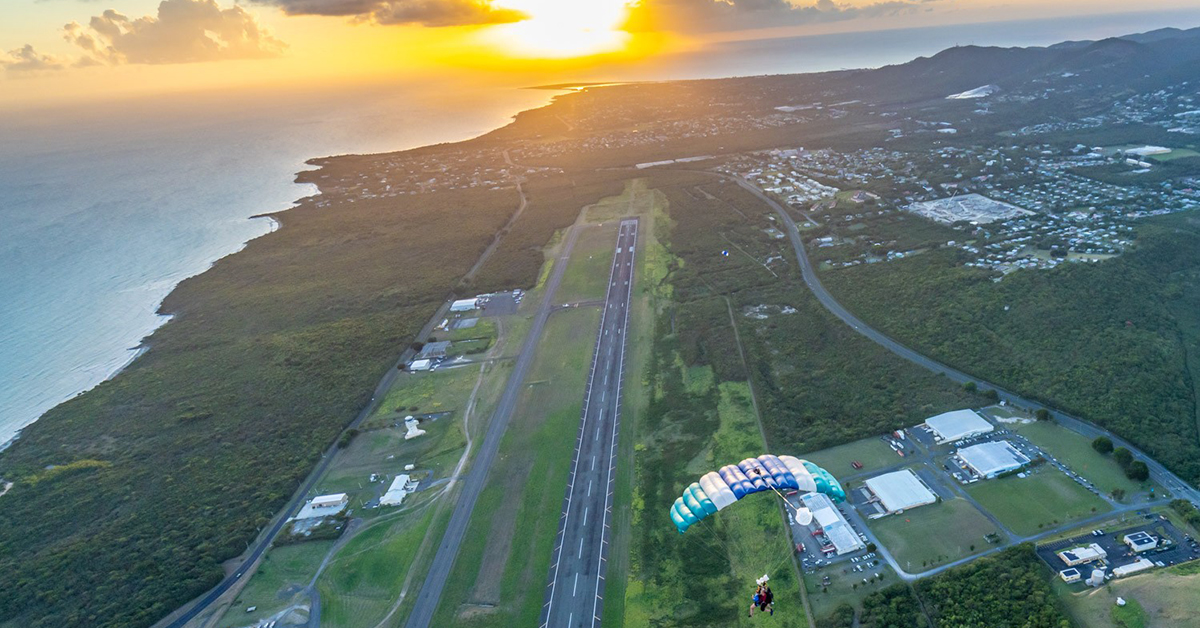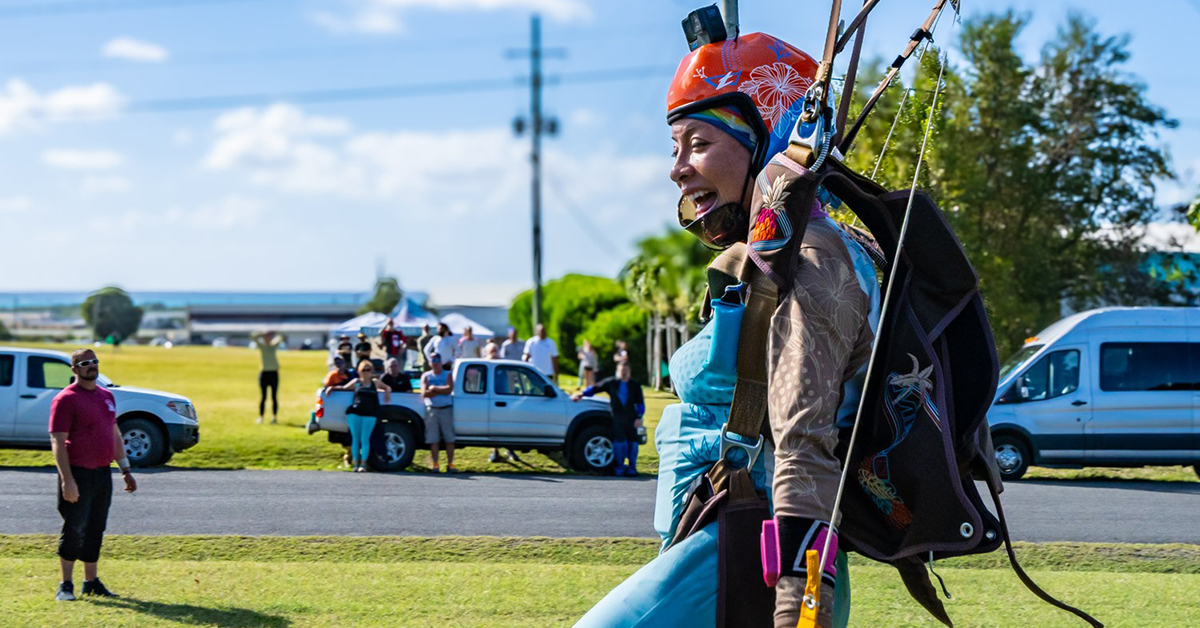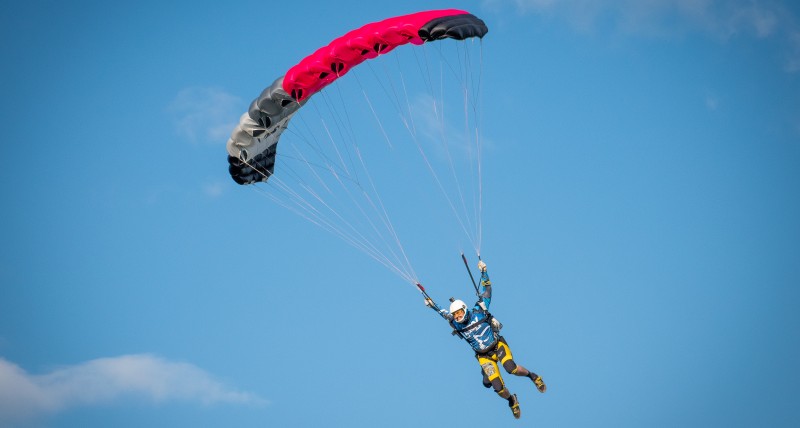How to land when the sock is sideways
All photos by Norman Kent
Like it or not, life isn’t always a goofy improv. Sometimes, you have to stay on the straight and narrow. Literally.
When?
Well… You might find yourself landing a reserve on a narrow road. You might be finagling your way into a safe pattern after the long trek back from a bad spot. Heck, you might even be putting that tiny little cross-braced thang down in front of a demo crowd. Sometimes, landing a ram-air canopy and walking along a slackline can be toe-tinglingly similar activities. It pays to be ready for that moment.
Nobody’s going to argue that landing directly into the wind is the best way to go. That said, we’re not always that lucky, are we? The rock-paper-scissors of this is unequivocal: your landing direction is more important than the wind direction.
Here’s how to make the balance work.
1. Measure up the options
Crosswind landings are generally necessitated by a long, narrow, clear path between obstacles, either visible (trees, power lines, toddlers!) or transparent (swoop lane, beer line, the next-door skydivers’ patterns). The configuration tends to delineate a runway.
In a dropzone situation, crosswind landings may very well be necessitated by:
- the shape of the landing area, in reference to
- the wind direction and
- the pattern you’re required to follow
If you get really unlucky with the way those three factors line up for you on a jump, you have a three-point set of responsibilities:
- to conform to the criteria
- to be as predictable as possible and
- to keep from blowing into the path of other skydivers
If everyone on the load is on their game and doing the same, it won’t be as bad a day as it could be otherwise. Don’t be the jumper that blows it.
Along those lines, if you can avoid the crosswind do-si-do entirely by putting it down in an alternate landing area, just do it. It’ll be worth the walk.
2. Get your crab on
Ask any airplane pilot: landing with the wind at an angle to the runway is, like, totally normal. Ask any beach-dropzone bum or ridge rat paragliding pilot, and they’ll definitely elaborate on the technique of landing smoothly with the wind pushing in (sometimes, none-too-gently) from the side. That manoeuvre is called “crabbing”. The difference between the direction the nose is pointing and the pilot’s path (“ground track”) is called the “crab angle”.
Don’t worry: in these conditions, your ram-air wing will fly just fine with the nose pointed at a gentle angle from the path your flight describes along the “runway”. They’re built for it, after all.
3. Remember: Angle matters
Your biggest task when you line up a crosswind landing is to finagle for yourself as much of a headwind as possible while keeping away from the obstacles you’re working to avoid. Anything up to a 90-degree crosswind will work (basically, you’re aiming to avoid a tailwind).
Another word of advice: use the longest “runway” you can find – you want a solid margin for error.
If you’re so mathematically clever that you can work this out on your downwind leg, you can estimate the crosswind component using this rule of thumb: if the wind differs from the runway heading by 15 degrees, the crosswind component is roughly 25 per cent of the wind velocity.
If you can’t do maths on a skydive, you’re normal. Just know that any safe angle you can snag towards into-the-wind will win you a drop in ground speed.

4. Get creative
As you come in on that final, you’re going to be doing a bit of a dance with the sideways wind. It will invariably be pushing you towards something you do not want to fly into. It may be pushing you unevenly. And it might be pushing you pretty darn hard.
Your approach, therefore, will be a little less regimented than your typical downwind/base/final box. You’ll most certainly notice that your downwind leg is not quite downwind, and that you’re not getting the distance you’re used to. What’s usually your base leg is likely to be the actual downwind. Your mission: to keep it from pushing you into the danger zone.
5. Keep your focus on the right target
As you tuck into your final approach, glue your eyes on the middle of the far end of the “runway”. Nail them there. Staple them there. Weld them there. Do not start looking at the obstacles to either side, or you are very likely to get suddenly intimate with them.
6. Let it do its thing
From this point to touchdown, you have one job: keeping the canopy level while you fly in a straight line. Calmly make the necessary inputs, without overcorrecting, and let the nose point in the direction it needs to point.
A word of warning: the path might seem wiggly. Don’t let that motion distract you from maintaining your heading. Any inputs required to keep that straight-line heading will simply increase your crab angle and point your nose into the wind, slowing you down.
7. Come to a full and complete stop
To flare in a crosswind, make a slight adjustment to your normal procedure: use moderate emphasis on the upwind brake to get into a wind-facing position. If you don’t, you’ll certainly be running out your landing.
If you do run out your landing, that’s fine. If you PLF, that’s also fine. If you run out your landing, PLF, front-flip and land on your feet with a whoop, that’s… beer.
If you pull it off without endangering yourself or any other skydiver, congratulations. You have officially won the crosswind game.
The CT manual states:
Your three landing priorities are (in order):
1. Land under a flat, level and fully flared canopy
2. Land into a hazard free area
3. Land into wind (but not at the expense of priorities 1 and 2)



